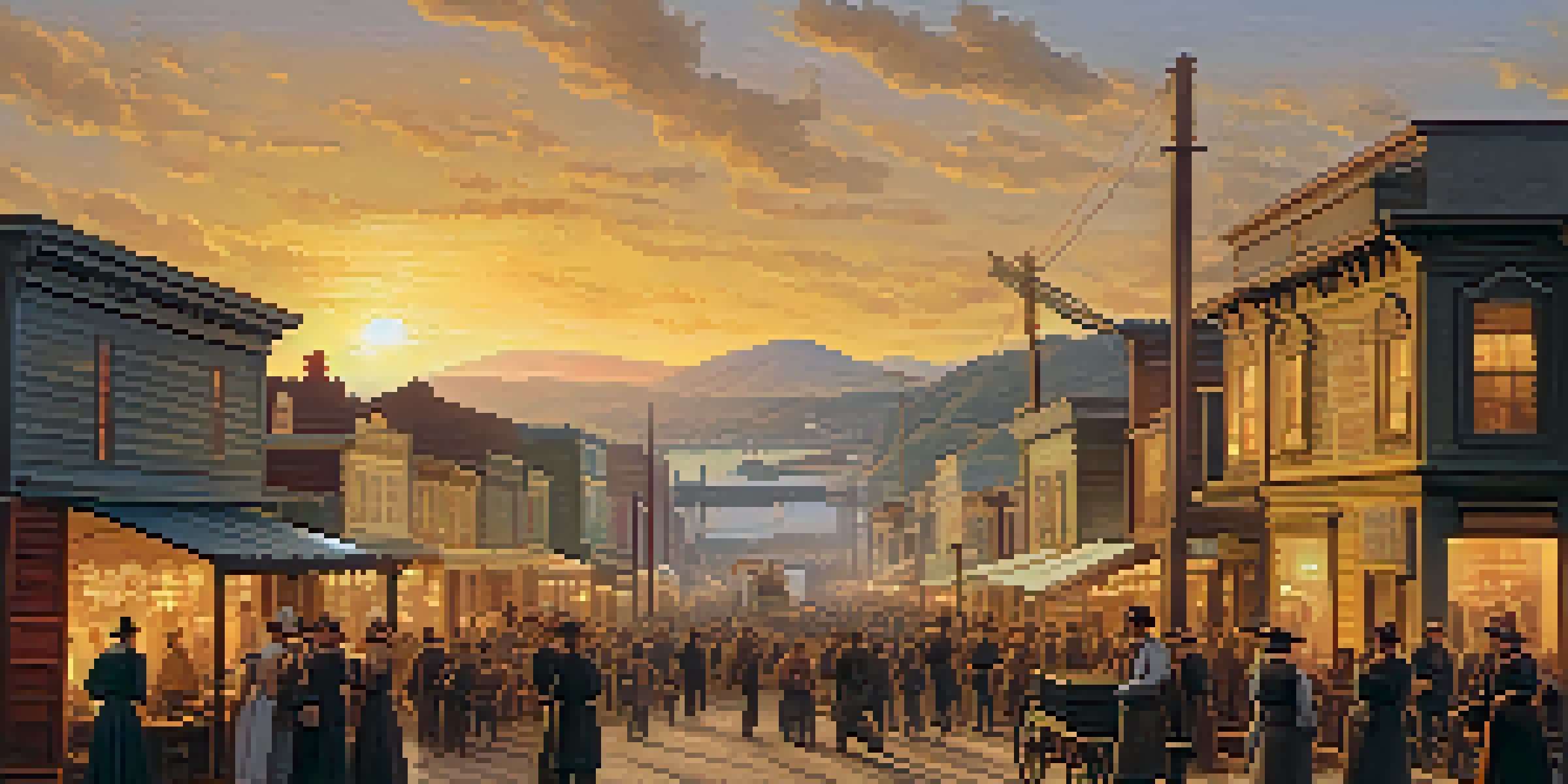The Gold Rush: How Fortune Seekers Transformed San Francisco

The Spark: Discovery of Gold in California
In 1848, James Marshall's discovery of gold at Sutter's Mill ignited a frenzy. This seemingly simple find marked the beginning of a monumental chapter in American history. It was a moment that transformed a quiet California settlement into the epicenter of hope and ambition for thousands.
The discovery of gold in California was not just a rush for riches; it was a rush for a new life, a new identity, and a new beginning.
News of the gold rush spread like wildfire, drawing fortune seekers from all corners of the globe. People left their homes, jobs, and families in pursuit of wealth, believing that a handful of gold could change their lives forever. This surge of hopeful prospectors would soon redefine the very fabric of San Francisco.
The initial trickle of gold seekers quickly turned into a deluge, with over 300,000 people arriving in California by 1855. San Francisco's population exploded, setting the stage for both opportunity and chaos that would shape the city’s future.
The Rapid Growth of San Francisco
As the gold rush attracted more settlers, San Francisco transformed from a sleepy port town to a bustling city almost overnight. With its population soaring, buildings sprang up to accommodate the new residents, many of whom lived in makeshift homes. This rapid growth created a unique blend of cultures and backgrounds, turning San Francisco into a melting pot.

The influx of fortune seekers also led to booming businesses. From saloons to supply shops, entrepreneurs seized the moment, catering to the needs of miners. This economic boom laid the groundwork for what would become a vibrant commercial hub.
Gold Rush Transformed San Francisco
The discovery of gold in 1848 led to an explosive population growth and economic boom, redefining San Francisco from a quiet settlement to a bustling city.
However, this rapid development came with its challenges. San Francisco grappled with inadequate infrastructure, leading to overcrowded streets and a lack of basic services. Yet, this chaotic environment was part of what made the city so dynamic and resilient during the gold rush era.
The Impact on Local Indigenous Communities
While the gold rush brought prosperity to many, it had devastating effects on local Indigenous populations. As miners flooded into California, they encroached on ancestral lands, leading to displacement and cultural upheaval. The promise of gold often overshadowed the rights and lives of Indigenous communities.
In the chaos of the gold rush, the true wealth lay not just in gold but in the diverse stories and cultures that emerged.
Conflict became inevitable as miners clashed with Native Americans over resources and territory. Many Indigenous people faced violence and loss of their traditional ways of life. This dark chapter in history serves as a sobering reminder of the gold rush's complex legacy.
Moreover, the gold rush led to significant demographic shifts in California. The influx of settlers altered local ecosystems and disrupted centuries-old practices, highlighting the often-overlooked consequences of the quest for fortune.
The Role of Women in the Gold Rush
Though often overshadowed by their male counterparts, women played a crucial role during the gold rush. Many women traveled to California seeking their fortunes, while others came to support their families. Their resilience and resourcefulness were essential in navigating the challenges of this tumultuous time.
Women established businesses, opened schools, and provided healthcare, contributing significantly to the burgeoning community. They helped shape social dynamics, bringing a sense of stability amidst the chaos of gold fever. The stories of women like Phoebe Apperson Hearst highlight their impact on the city’s growth.
Consequences for Indigenous Peoples
The influx of miners during the gold rush caused significant displacement and cultural upheaval for local Indigenous communities, highlighting the darker aspects of this era.
This period also marked a shift in societal norms. As women took on new roles, they challenged traditional expectations and laid the groundwork for future generations. Their contributions were foundational in transforming San Francisco into a more inclusive society.
The Rise of Law and Order Amidst Chaos
As the population surged, so did crime and lawlessness in San Francisco. Miners and fortune seekers often resorted to violence over disputes, leading to a chaotic environment. This prompted the need for a more structured legal system to maintain order in the rapidly growing city.
In response, local citizens formed vigilance committees to combat crime and protect their communities. These grassroots organizations took the law into their own hands, enforcing order in the absence of a formal police force. This unique approach to law enforcement reflected the urgency of the situation.
Over time, the establishment of a formal police department helped stabilize the city. The struggle between lawlessness and the creation of order became a defining feature of San Francisco’s early narrative during the gold rush.
Cultural Transformation During the Gold Rush
The gold rush not only influenced economics but also sparked a cultural renaissance in San Francisco. As diverse groups converged in the city, they brought their traditions, languages, and cuisines, creating a rich tapestry of cultural expression. This vibrant mix laid the foundation for San Francisco's reputation as a cultural hub.
The arts flourished during this period, with theaters, galleries, and music venues springing up to entertain the throngs of miners and settlers. Events like the California State Fair showcased local talent and fostered a sense of community. These cultural developments were pivotal in establishing the city’s identity.
Cultural and Economic Legacy Endures
Though the gold rush declined by the late 1850s, its cultural and infrastructural impacts laid the foundation for San Francisco's future as a major commercial and cultural hub.
Moreover, the gold rush fostered a spirit of innovation. Entrepreneurs and artists alike were inspired to push boundaries, leading to advancements in various fields. This environment of creativity would continue to thrive long after the gold rush ended.
The End of the Gold Rush and Its Legacy
By the late 1850s, the initial excitement of the gold rush began to wane as gold became harder to find. Miners moved on in search of new opportunities, and San Francisco faced a new challenge: sustaining its growth without the gold influx. The city had to adapt to a post-gold rush reality.
Despite the decline of mining, the infrastructure and cultural developments established during the gold rush laid the groundwork for San Francisco's future. The city evolved into a major commercial and cultural center, attracting new industries and residents. Its legacy as a gold rush town remained an integral part of its identity.

Today, we remember the gold rush not just for the wealth it generated, but for the profound transformations it brought to San Francisco. The stories of struggle, resilience, and ambition continue to resonate, reminding us of the city’s dynamic past.